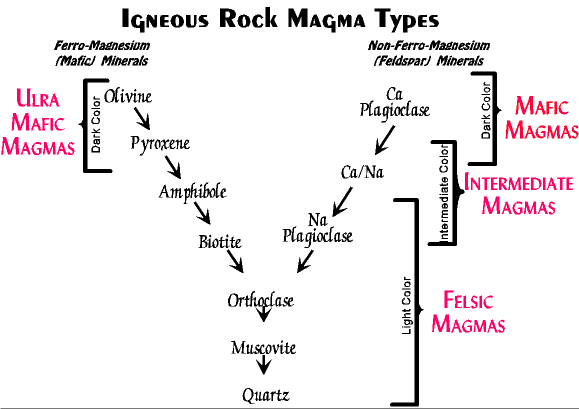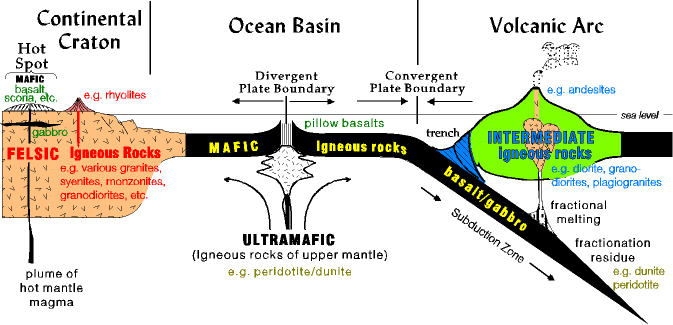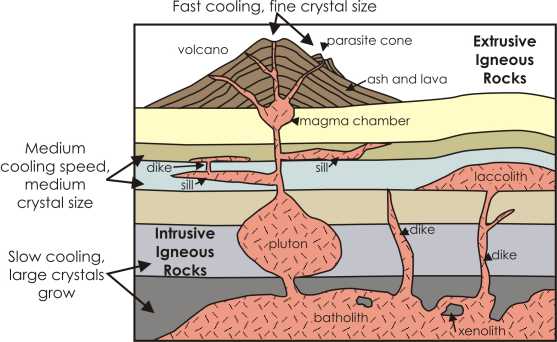
GOL-105
Chapter 4. Igneous rocks
Rock Cycle

How does magma form?
Probable causes of melting:
1. Geothermal gradient: (gg)
The rate at which temperature increases with increasing depth beneath the surface.
In an average it is ~25°C/KM on Earth.
However it is not the same everywhere
Much higher (up 70°C/KM) in an active volcanic region, and lower at plate interiors (17°C/KM).
Beneath volcanic regions to melt the rocks there is no need for larger depth (70°C/KM.). However beneath a plate interior, much larger depth is necessary for melting (17°C/KM.).
2. HOT MANTLE PLUMES
Hot spots in the crust (with very high local geothermic gradient), usually above hot mantle plums (Hawaii) probable Yellowstone park.
3.FRICTION
Rocks girding past rocks may generate heat as well. (along tectonic zones).
4. HEAT TRANSFER
Heat from magma body may pass through country rocks and heat them. crystallization o f magma releases lots of heat.
CONTROLLING FACTORS
a. PRESSURE
The temperature of melting increases with increasing pressure. Pressure on the other hand increases with increasing depth, which means if a rock would melt at the surface at a certain temperature, it would need much higher temperature to melt in the mantle.
b. Presence of water under pressure
If enough gas especially water vapor is present under high pressure, the melting temperature will be lower. ex. water pressure in granite lowers the melting temperature from 900 °C to 650°C.
c. MIXING MINERALS
Will lower the melting temperatures.
How magmas of different composition evolve?
Differentiation
As the magma starts to crystallize the forming solid crystals separate out, gradually changing the composition of the remaining magma.
(Like the whole milk differentiates into cream and skim milk).
A scientist named Bowen had a high temperature laboratory, where he constructed a series of experiments, and figured out the order of crystallization. He collected different igneous rocks, and melted them together. He observed, that the minerals which crystallize first have higher melting temperatures than those which would crystallize as last.
CRYSTALLIZATION BEGINS ALONG TWO BRANCHES
Discontinuous Branch
1. The first mineral to crystallize is Olivine with very high Fe, Mg. After olivine crystallized the remaining liquid has less Fe, Mg, and more Si.
2. As the magma further cools down, it reaches the melting temperature of pyroxene, and it begins to crystallize. Some pyroxene would form from previous olivine by reacting with the melt, others crystallize from the melt, till the temperature reaches the melting temperature of amphibole.
3. Pyroxene might also react with the melt and rearrange into amphibole
4. The next step is biotite.
Any magma left after biotite, has no Mg, and Fe
CONTINUOUS BRANCH
CA, NA FELDSPARS
Plagioclase feldspars
The Ca rich plagioclase starts to crystallize, with the highest melting temperature. As the temperature cools, more and more Na incorporates into the structure. This branch is crystallizing continuously until all the Na and Ca is gone.
If there is any more melt left, it will have a lot of Si and K and Al .
Potassium feldspar will form if the magma is dry (No H2O content)
muscovite will form if water vapor is present
The last phase to crystallize if there is still melt is pure silica: QUARTZ

http://csmres.jmu.edu/geollab/fichter/IgnRx/HTMLimag/magmatyp.gif
Bowen used his experiment to prove, that every kind of igneous rock could form from a single magma called parent magma (by differentiation).
In reality there is differentiation, but rare .
Most of the time there are different magmas forming . Magmas with low or high SiO2 content. SiO2 content is very important.
Ultra MAFIC: Very low SiO2. Less than 35%.
MAFIC: LOW SiO2 between 35- 45%
INTERMEDIATE:45-60% SiO2
FELSIC:MORE THAN 60% SiO2
Plate tectonics and magma formation
We know, that the mantle has very low SiO2 content,
and the continental crust has high SiO2.
How magmas with different composition can form?
Along mid-oceanic ridges we have mafic magma forming
What happens along subduction zones?
1, oceanic/oceanic crust + sediments (Deep water sediment is mostly kaolinite (high SiO2 content) and lots of seawater+ low SiO2 oceanic crust===intermediate magma will form, Melting temperature will be relatively low because of the presence of ocean water
2. collision, or oceanic +continental plate boundaries felsic continental crust, + seawater, +kaolinite sediment ======felsic magma will form

http://csmres.jmu.edu/geollab/Fichter/IgnRx/disthtml.html
Assimilation
Magma forms somewhere else intruding and melts some of the surrounding rocks
Partial melting
When the temperature is not high enough to melt the whole rock, the minerals with the lowermost melting temperature will melt, resulting in the formation of more felsic magma than the original composition.
VISCOSITY
Viscosity tells us how the magma is able to flow, and helps us to know how violent an eruption will be.
Viscosity depends on:
1. temperature
higher the temperature the higher the ability of the magma to flow (less viscous) like water
2. SiO2 content of the magma
The more SiO2 the magma has the higher the viscosity will be. In the melt more and more SiO2 will result in more complex huge silicate structures, and it slows down the flow ability (honey)
Depth of crystallization
If the magma will not reach the surface it will produce INTRUSIVE igneous rocks
![]() If
it gets to the surface EXTRUSIVE rocks will be produced.
If
it gets to the surface EXTRUSIVE rocks will be produced.
HOW DO WE KNOW THE DIFFERENCE:
INTRUSIVE: SLOW COOLING ----------LARGE CRYSTALS
EXTRUSIVE:FAST COOLING -----------SMALL CRYSTALS
extrusive molten magma is LAVA
TEXTRURE OF IGNEOUS ROCKS
Phaneritic
The characteristic intrusive texture
 Each
crystal is visible with naked eyes
Each
crystal is visible with naked eyes
Extrusive texture types:
1. Porphiritic (mixed)
 Some crystals are visible,
but most in the so called matrix is invisible for the naked eye.
Some crystals are visible,
but most in the so called matrix is invisible for the naked eye.
2. Aphanitic
 Very few tiny crystals, most
everything is invisible in the matrix.
Very few tiny crystals, most
everything is invisible in the matrix.
3. glassy (hyaline)

4. vescicular
 Volcanic
glass with gas bubbles
Volcanic
glass with gas bubbles
5. Pyroclastic
Classification of igneous rocks
1. Felsic group
Intrusive version: Granite
Texture:
Phaneritic 
Composition: Quartz, K-feldspar, Biotite, Amphibole
Extrusive versions: 1. Ryolite
Texture:
Aphanitic 
Composition: Same as granite,
Visible: few tiny feldspar, Biotite, Amphibole crystals
Extrusive versions: 2. Obsidian
Texture: Glassy
Composition: Same as granite,
No visible
minerals 
Extrusive versions: 3. Pumice
Texture:
Vesicular 
Composition: Same as granite, no visible minerals
2. Intermediate group
Intrusive version: Diorite
Texture:
Phaneritic 
Composition: Na-plagioclase, Biotite, Amphibole
Extrusive versions: Andesite
Texture:
Porphiritic 
Composition: Same as Diorite
Visible: Some Biotite, Amphibole crystals
3. Mafic group
Intrusive version: Gabbro
Texture: Phaneritic
Composition: Ca-plagioclase, Olivine, Pyroxene, Amphibole
Extrusive versions: 1. Basalt
Texture: Aphanitic
Composition: Same as gabbro
Visible: few tiny olivine
Extrusive versions: 2. Porphiritic basalt
Texture: Porphiritic
Composition:
Same as gabbro 
Visible mineral: pyroxene
Extrusive versions: 3. Scoria
Texture:
Vesicular 
Composition: Same as gabbro, but no visible minerals
4. Ultramafic group
Intrusive version: Dunite
Texture: Phaneritic
Composition: Olivine, Pyroxene
Occurence of igneous rocks
Most magma is imp laced at depth and never come to the surface. They are called
PLUTONS
we can only study them after erosion
Dike: discordant
Sill: tabular plutons formed along sedimentary layers (Palisades sill) Their depth is shallow, they often very similar to volcanic rocks. (basaltic most of the time)
Laccoliths
More viscous magma makes it, but similarly shallow as sill. lens shape
Volcanic Pipes and necks
 From
Williams (1936).
From
Williams (1936).
The volcano generally have a cylindrical conduit named volcanic pipe. Usually it is more durable than the surrounding rocks, therefore it is more resistant to erosion.
 http://seis.natsci.csulb.edu/basicgeo/INTRUSIONS/Intrusive_volcanic_neck.jpeg
http://seis.natsci.csulb.edu/basicgeo/INTRUSIONS/Intrusive_volcanic_neck.jpeg
batholiths
Huge intrusive bodies, Idaho batolith is 40,000Km2
(granitic)
